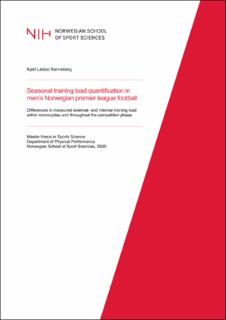| dc.description.abstract | Introduction: Due to the complex match scheduling in football, a proper periodization strategy is necessary to avoid fatigue and injuries and optimize physical performance prior to match play. The purpose of this study was to quantify and examine differences in training load and intensity within microcycles and between mesocycles throughout the competition phase.
Methods: A GPS unit with a built-in accelerometer (Catapult OptimEye X4) and selfreported internal load (RPE) were used by elite Norwegian premier league players (n=10; Age=27 ± 3) throughout the 2018 competition phase. Data was collected on MD (match day)-4, MD-3, MD-2 and MD during normal microcycles containing 1 game and 4 training sessions for external (17 microcycles, n = 563 samples) and internal load (17 microcycles, n = 475 samples). Full-team differences in training load and intensity within microcycles and between mesocycles (4x5week blocks) were examined. Analyzes were performed for total distance covered (TDC), high-speed running distance (HSRD), sprint distance, PlayerLoad™ (PL™), RPE and sRPE, all in absolute values and relative to match play.
Results: MD showed higher TDC, HSRD, sprint distance, PL™, RPE and sRPE compared to all training days (Effect size: 2.9-13.9). Differences between MD-2, MD-3 and MD-4 was also present: higher HSRD and sprint distance closer to MD (MD-2 > MD-3 > MD-4) and lower values for TDC, PL™ (MD-2 < MD-4 < MD-3) and internal load (MD-2 < MD-3 < MD-4), was observed closer to MD. Differences were also observed between mesocycles: higher TDC in mesocycle 5 compared to the others (Effect size: 0.5-0.6) and lower HSRD and sprint distance in mesocycle 6 compared to the others (Effect size: 0.1-0.8). Lower TDC×min-1 and PL™×min-1 in mesocycle 3 compared to the others were also observed (effect size: 0.7-3.3).
Conclusion: Day-to-day differences in measured TL and intensity within microcycles were observed. Besides an increase in HSRD and SPRINT, a decrease in other variables preceding match play were observed, suggesting a tapering strategy towards MD. Differences between mesocycles were also prominent, with a decrease in HSRD and sprint distance in the last mesocycle compared to the others. Meso 3 produced the lowest intensity for TDC×min-1 and PL™×min-1 despite a different pattern for the corresponding TL variables, suggesting duration to be the main altered component. | en_US |
